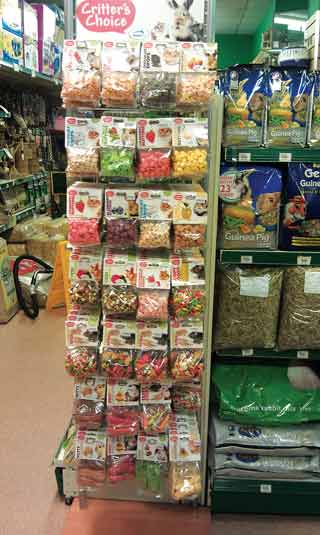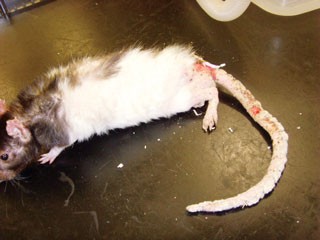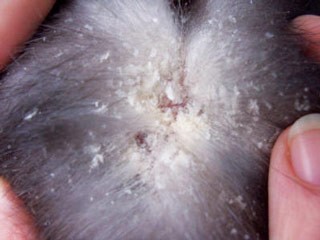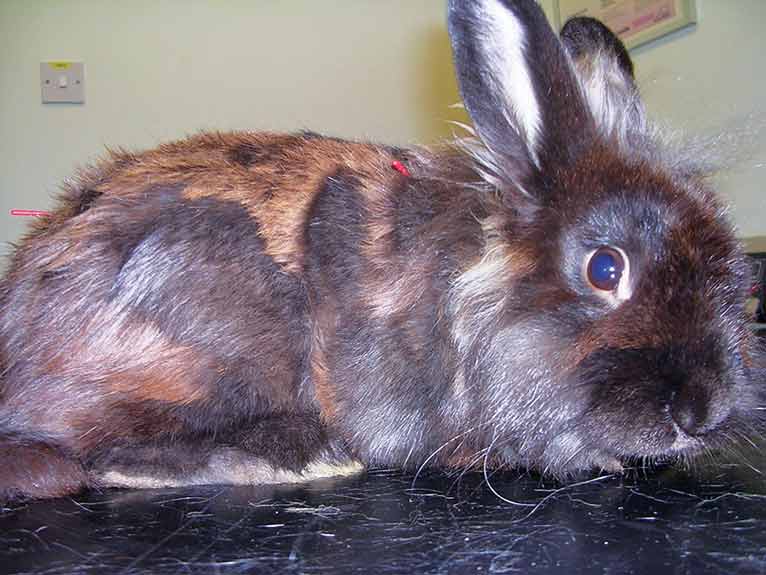7 Sept 2015

Figure 4. A rabbit receiving acupuncture for arthritis. Note the different hair colouration where it has grown back post-hair loss through parasites.
General care of small mammals is directly related to their natural behaviour, environment and nutritional requirements. The following five freedoms also need to be used to establish what care of these animals entails:
General management of rabbits and small furries starts with correct housing. Rabbits can live for as long as eight to 12 years, so purchasing good quality hutches and runs is important as they need to last.
A hutch should be tall enough for a rabbit to stand up in, without its ears touching the roof (a medium-sized rabbit will need about 75cm) and long enough for a rabbit to complete three consecutive hops and lie out fully stretched.
Many animal species are social – especially rabbits – and need company of others, therefore additional space requirements should be taken into consideration if more pets are going to be adopted at a later date.
Animals need to be able to exercise fully, so access to runs or secure areas is necessary. Animals need access to exercise at their most active times of day. For rabbits, this tends to be early morning and late afternoon, while for other species this can be more at night time.
Hiding places and platforms are not just for cats – rabbits and small furries enjoy sitting up on platforms too, where they can scan their environment for predators. Platforms can also help with an animal’s overall fitness when jumping on and off – just ensure they are weight-bearing and can’t topple over. Being prey species, hiding places are also important for rabbits and small furries, and should be available at all times. Tunnels, large cardboard tubes, cardboard boxes and purpose-built hiding holes are excellent additions to the animals’ environment.
Rabbits and small furries love to dig, so a sand box to dig and play in can be positive. Large cat litter trays are ideal, either filled with earth, child-friendly sand, shredded newspaper or chinchilla bathing sand. Cardboard boxes can also be used, but need to be moved when it rains.
Prevention of mental suffering in these animals is vital, therefore they must be able to exhibit normal behaviour such as chewing and foraging. The diet and products chosen can aid animals in this regard. Using food to enrich the environment for rabbits and small furries is easily achieved and many products are available such as food balls, tubes filled with hay to hang up and willow twig balls.
In their natural habitats, these animals would spend a vast proportion of their time foraging and chewing their food. Without this, boredom can occur and this will also impact on dental and digestive health.
Though always sold in pet shops – like sweets in supermarkets – high-sugar treats and snacks (Figure 1) should be avoided in large quantities in these species for various reasons. Guidance should be given about treats and, if offered, should be done so sparingly. Engaging children to help enrich a pet’s environment with suitable toys and ideas on where to hide food can be a really positive step for the overall health of a pet.

Diet not only impacts on foraging behaviour, but also on a pet’s dental health. Species such as rabbits have evolved to eat a very low-quality diet and need high levels of non-fermentable fibre. High-sugar diets will ferment in the caecum and cause gastrointestinal upsets such as bloating, diarrhoea and, if ignored, gut stasis.
The diet of rabbits and other small mammals needs to be consistent as they rely on bacteria in their digestive systems to break down food. When diets are changed suddenly, it can mean the wrong types or numbers of bacteria required to digest the new diet are not present, which can result in diarrhoea.
Good quality, clean hay such as meadow or Timothy are best for rabbits, should be available at all times and should not be used as bedding – hay is for eating, straw is for bedding.
Straw is a better isolator and many animals don’t like eating hay that has been slept in or soiled on. Encouraging these animals to consume hay can be difficult if they are not used to it. Hay nets, racks and cubes are good ways of introducing hay and keeping it clean.
As with horses, soaking the hay is a good way of increasing the water content of a diet, if required, but can also change its palatability. Hay should only be dipped in water and not allowed to ferment as this can also cause issues. Soaked hay that smells sweet is starting to ferment. Each rabbit should eat roughly its own body volume in hay or grass each day.
Cleanliness of cages and hutches is important – especially in outdoor hutches during warmer periods. Fly strike (myiasis) is a common problem encountered in rabbits in which flies lay their eggs directly on to a rabbit’s coat. The larval stages (maggots) will feed directly off the pet. Good advice regarding husbandry and nutrition is required to aid in the prevention of this life-threatening issue.
Cages and hutches need to be regularly and thoroughly cleaned with an appropriate cleaning agent; some can also aid in the control of parasites. Diarrhoea can be an initiating cause for flies to be attracted, so good advice on diets high in fibre can be required. All rabbits and guinea pigs should have regular dental checks to ensure their teeth are not causing issues.
Rabbits and small furries can be easily house-trained and will often use only one small area of their hutch/cage to toilet in. Cat litter trays or purpose-made small mammal toilets can be useful to keep an animal’s environment cleaner, but should still be cleaned out daily.
Poor hygiene and poor ventilation can quickly cause respiratory problems. Good quality, non-toxic cleaning products for these specific uses should be used.

Disease prevention is important and many parasiticides for rabbits and small furries fall under the Small Animal Exemption Scheme, so can be dispensed without prescriptions. Ectoparasite control is one of the most commonly seen problems in small furries (Figure 2).
Cheyletiella parasitovorax, also known as walking dandruff (Figure 3), is a mild dermatitis caused by fur mites in rabbits. It is primarily transmitted by direct contact between infested and non-infested rabbits. The mites can survive in the environment for several days, so spread may also occur through contaminated hay or bedding.

Owners need guidance on accurately weighing their pets to ensure the correct parasiticide dose is administered at the correct interval and ways to prevent the issue from occurring again. Ivermectin spot-ons are ideal for use in these situations.
An animal’s response to C parasitovorax very much depends on the animal. In some there can be limited signs, such as a small patch of dry skin, while in others the whole animal can be infested, with clumps of hair coming out.
It is quite possible for two rabbits to live together and one be very badly affected, while the other is fine. There is a big individual variation in how much rabbits are affected by Cheyletiella (Figure 4).

The mite (Figure 5) is present in the environment at all times, if it is not regularly disinfected, and the animal may be affected because of a bad batch of hay or straw – or sometimes if it is ill for other reasons and its immune system is low.
There are lots of ways in which we can easily improve the health and well-being of rabbits and other small furries by enriching their environment.
We just need a bit of imagination and a really good understanding of our pets’ normal behaviour.